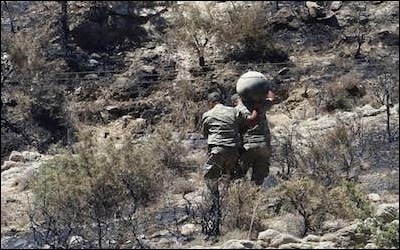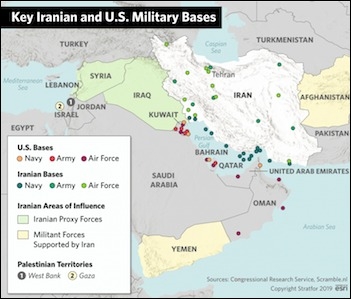by Seth Frantzman
An arc of simmering conflict runs from the waters off Cyprus to the Gulf of Oman
Originally published under the title "Know This: A U.S.-Iran War Would Not Be Fought Only in Iran."

Soldiers
carry off debris from the errant S-200 near the village of Tashkent, 12
miles northeast of the Cypriot capital, Nicosia.
|
An arc of simmering conflict runs from the waters off Cyprus to the Gulf of Oman where the U.S. Global Hawk was downed in June, to Abha in Saudi Arabia which has been targeted by Iranian-backed Houthi drones. It is a frontline that stretches three thousand miles and marks out the potential flashpoints between the United States and its allies against Iran and its allies and proxies. Viewing the region through this complex map of interlinked conflicts is the best way to see the current U.S.-Iran tensions in the context in which they have grown. It also reveals the possible ways Iran and its proxies might strike at the United States and its allies. In some cases these conflicts have already broken out.
Iran is seeking to raise tensions in the Gulf, Iraq and Yemen among its allies and proxies.
|
After the Trump administration left the Joint Comprehensive Plan of Action, or Iran deal, in 2018, Iran has been subjected to new sanctions. Tehran has warned that if European powers cannot find a way to meet its demands for a way around these strictures it will break through agreements about the amount of enriched uranium it stockpiles. This has now occurred and further threats have been issued.
The larger picture is that Iran has been nurturing its role in its near abroad, particularly Iraq and Syria, and providing support to Hezbollah in Lebanon and the Houthi rebels in Yemen. Much of this support is well known. For Hezbollah it means not only financial packages but also precision guidance for a rocket arsenal that now numbers up to 150,000. Hezbollah has said all of Israel is within its range. In the waning days of 2018, Israel launched an operation along its northern border to ferret out Hezbollah tunnels. This was a warning to Beirut that Israel knows what Hezbollah is up to.

Iran has indicated that a conflict with the United States would result in attacks on Israel. Mojtaba Zolnour, chairman of the Iranian parliament's National Security and Foreign Policy Commission said Israel would be destroyed in the event of war with the United States, according to a report on July 1.
That could mean a Hezbollah-Israel war, but it could also mean opening up a front in Gaza and in Syria. For instance, Iran has supported Hamas, which has run Gaza since 2006, and Islamic Jihad, a militant Palestinian group that has fired rockets at Israel from Gaza over the last year. Using its Iron Dome air defense system, Israel has deflected most of the more than 1,000 rockets fired since March 2018, thus foregoing the need for a large ground offensive like the ones that took place in 2009 and 2014.
Iran has also established bases and infrastructure in Syria. This includes Islamic Revolutionary Guard Corps (IRGC) bases that have been used to support the Syrian regime of Bashar al-Assad in the conflict against the Syrian rebels since 2011. There are also Iranian-backed militias from Iraq who have gone to Syria to serve in the conflict. The existence of this Iranian infrastructure has generally been revealed through tensions with Israel. More than one thousand airstrikes by Israel against targets from Damascus to two hundred kilometers north in Latakia and Homs provinces, reveal the extent of Iran's role and Israel's desire to reduce or at least stall the growth of Iranian entrenchment.
Iran has established IRGC bases and infrastructure in Syria
|
The simmering conflict puts Syrian air defense in an awkward position. If it doesn't defend its Iranian ally that will be seen as giving Israel a carte blanche to do as it wants. But Syrian air defense has also proved remarkably erratic. In September 2018, an S-200 fired at an Israeli warplane struck a Russian plane that was landing in Latakia. Angered, Russia said it would supply Syria with the S-300 air defense system. That system remained dormant until June 30 when a satellite image from ImageSat International showed it deployed near Masyaf. It wasn't clear if it was operational and when Israeli struck targets nearby the next day the system did not appear to be used. Instead another S-200 fired wildly went out to sea and hit a mountain in northern Cyprus. In another instance in 2017, a Syrian missile flew over Jordan and had to be intercepted by Israel's Arrow 3 defense system. Syria's one success was a missile that targeted an F-16, leading to the plane crashing in northern Israel.
Israel's frontline in a potential growing crisis with Iran is clear. It could involve Gaza, southern Lebanon and targets in Syria. In the past Israel has warned that Hezbollah's role in Lebanon, where it controls the Health Ministry and has a powerful political and military presence in the country, has ramifications for Lebanon in general. This will be a more serious conflict than the one in 2006, which was a precursor of worse to come. Hezbollah's weapons have increased in precision and it has thousands of battle hardened men who fought in the Syrian Civil War. Israel's air defense and arsenal has also increased.
For the United States, the arc of confrontation with Iran stretches down the Euphrates river in Syria where U.S. forces and their partners in the Syrian Democratic Forces defeated the Islamic State in March of this year. In addition, the United States continues to play a role in Tanf, a barebones desert base established in Syria near the border of Iraq and Jordan. The base was supposed to train anti-ISIS fighters, but its long-term fate is unclear. When President Donald Trump announced the United States would leave Syria in December 2018, it appeared to be on the menu to be folded up, but it is still there. The United States has warned Iranian-backed militias and Syrian regime forces to keep out of an exclusion zone around the base, which they have harassed in the past with bloody results.

US-backed Syrian Democratic Forces (SDF) fighters were instrumental in defeating ISIS.
|
Tensions with Iran also threaten U.S. forces in Iraq. For instance, in the spring of 2018, a quarterly Department of Defense report in May noted "Iranian support for certain PMF [Popular Mobilization Forces] militias posed the greatest threat to the safety of US personnel in Iraq." A more recent Inspector General report on the U.S. anti-ISIS campaign warned about the need to divert resources from the anti-ISIS fight to monitor Iranian threats in Iraq.
Trump said in December 2018 that the United States could use Iraq to "watch" Iran, leading Iraqi officials to respond that the country should not become an area of conflict. However, on May 14, U.S. officials say a drone was launched from Iraq targeting a pipeline in Saudi Arabia. Five days later, a rocket landed near the U.S. embassy in Baghdad, and the Washington has blamed Iranian-backed forces for the attack. In mid-July four days of rocket attacks followed, near U.S. forces in Camp Taji and Mosul, and against Balad Air base and oil facilities near Basra.
The rocket attacks, between the attack on two oil tankers on June 13 and the downing of the Global Hawk drone, formed part of a pattern of apparent threats to the United States in the Middle East. What they indicate is that any conflict with Iran could involve clashes in Iraq. The United States has already designated several large Iranian-backed Shia paramilitaries as terrorist groups in Iraq, such as Harakat Hezbollah al-Nujaba and Asaib Ahl al-Haq. These paramilitaries have been an official part of the Iraqi Security Forces since 2018. Press TV in Iran reported on July 2 that these militias are being increasingly integrated into the Iraqi armed forces. Iran has even proposed working with Iraq on air defense and conducting joint military drills with Baghdad. This creates a complex web of forces linked to Iran's IRGC and also the Iraqi government. If one of those groups was involved in the drone attack on Saudi Arabia or rocket attacks near U.S. forces, that paints a disturbing picture of worse to come in Iraq if tensions escalate.
From Iraq, the arc of contact between the United States and Iran is in the Gulf of Oman. Six oil tankers were sabotaged between May 12 and June 13. A sophisticated Navy Broad Area Maritime Surveillance Demonstrator U.S. drone was shot down on June 20. The United States has blamed Iran for all these incidents. U.S. airstrikes that would have targeted Iran in retaliation for the downing of the drone were subsequently called off, but F-22 raptors were sent to the Gulf at the end of the month to bolster B-52s and other U.S. naval and air force assets.
Across the Gulf of Oman in Yemen, Iranian-backed Houthi rebels have been fighting a Saudi Arabia-led alliance since 2015. Since the May incidents with Iran, the Houthis have increased their drone and cruise missile attacks on Saudi Arabia. An examination of the number of publicly known attacks reveals that they began in earnest on May 15 and continued unabated to the end of June. This included at least seven days of attacks directed at Abha city in southern Saudi Arabia and four days of attacks on Jizan. Iranian media has highlighted these attacks on airports, an indication of how they play into Tehran's regional views.
Iran sees its role in Yemen, Iraq, Syria and Lebanon, as well as its confrontation with the United States and U.S. allies, as an interlinked policy. Tehran works in a classic Clausewitzian manner in this regard, blending military and political goals alongside economic and cultural initiatives. For instance, on July 2 Iran's Tasnim News reported a new series of agreements between Iran, Iraq and Syria to facilitate a road network and trade between the three countries.
The theater of operations is an arc of simmering conflict stretching thousands of miles.
|
While a direct U.S.-Iran conflict has not broken out, there are already conflicts taking place between allies and proxies. This includes Israel's attempts to prevent Iranian entrenchment in Syria and also the conflict between the Houthis and the Saudi-led alliance. It is best to understand the Middle East through this paradigm today. This means looking at the Middle East as a series of interlinked confrontations between the United States and its allies, and Iran and its allies and proxies.
Washington has indicated that it views Iran as responsible for its proxies' behavior and its designation of the IRGC as an FTO was part of the Trump administration's attempt to draw these links into the open. Even if the administration subsequently seeks to change course, or a future administration seeks to return to the Iran deal, it will be necessary to manage all of the tensions from Lebanon to Yemen as part of any Iranian policy.
Seth Frantzman is The Jerusalem Post's op-ed editor, a Writing Fellow at the Middle East Forum, and a founder of the Middle East Center for Reporting and Analysis.
Source: https://www.meforum.org/58872/a-us-iran-war-will-not-be-fought-only-in-iran
Follow Middle East and Terrorism on Twitter
No comments:
Post a Comment